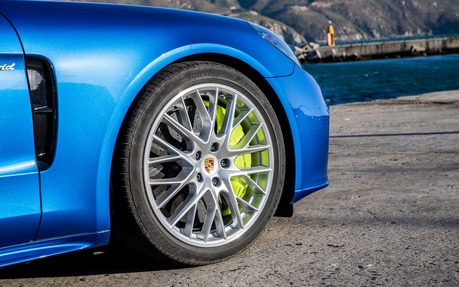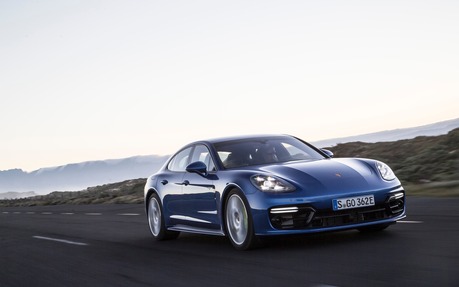2018 Porsche Panamera 4 E-Hybrid: Performance, Efficiency and Exclusivity
The Panamera 4 E-Hybrid is the latest addition to Porsche’s line of electrified vehicles and it comes with the technological advances introduced in the 918 Spyder. The previous version—namely the Panamera S E-Hybrid that launched in 2014—was the first of the brand’s vehicles to feature plug-in hybrid technology, but it featured rear-wheel drive, a Tiptronic automatic gearbox equipped and a "little" 9.4-kWh battery. The new 4 E-Hybrid is equipped with a twin-clutch gearbox, all-wheel drive as well as a liquid-cooled, 14.1-kWh battery, which is a major technical leap forward that greatly improves everyday driving.
A green signature
The Panamera 4 E-Hybrid comes with a regular or an extended wheelbase (on the Executive version), and style-wise it’s identical to the conventional-engined models. However, lime green brake callipers—which match the “Panamera 4” signature on the hatch opening and the “e-hybrid” inscription on the doors—make the hybrid models easy to spot. There’s also a telltale flap on the driver’s side to access the outlet.
According to Porsche, a complete recharge takes less than six hours using a 230-volt and 10-ampere connection. If the driver chooses to use the optional 7.2-kilowatt charger with a 230-volt and 32-ampere connection, the battery charges in less than four hours.

Fast, but heavy
The twin-turbo, 2.9-litre V6 borrowed from Audi and modified by Porsche as well as the electric motor offer a combined output of 456 U.S. horsepower and a peak torque of 516 lb.-ft. available between 1100 and 4500 rpm. The Panamera 4 E-Hybrid accelerates confidently and its 0-100 km/h time is 4.6 seconds, despite the fact that the hybrid version is much heavier than the conventionally powered Panamera 4.
In fact, the 2018 Porsche Panamera 4 E-Hybrid weighs 2170 kilograms (2250 kg for the extended-wheelbase Executive version), and you can really feel it when you lean into corners. Although the Panamera 4 E-Hybrid comes standard with the Sport Chrono Plus Package—which helps customize its performance and handling—and a capable air suspension, the laws of physics can’t be denied. And it’s also clear that it doesn’t have the same assertive personality as the 911 Carrera.
However, I’m willing to bet that the Panamera 4 E-Hybrid can still take corners faster than its direct rivals, the BMW 7 Series and Mercedes-Benz S-Class. On a ride that included highways, side roads and city traffic, we recorded an average fuel consumption of 10.5 litres per 100 kilometres. Porsche says this vehicle can cover 50 kilometres on electric power alone, but we weren’t able to confirm the range because our test car's battery wasn't fully charged when we set out.
Electric priorities
When starting, the Panamera 4 E-Hybrid gives priority to the electric engine. However, if you select the new Hybrid Auto mode, the car will select the most efficient drivetrain in response to the driver’s demands. If you’re driving down the highway, you can select E-Hold mode to save battery power for later, like when you’re rolling into town.
You can also recharge the battery with the E-Charge mode by driving with the heat engine engaged. Although this allows you to rack up electric energy for later use, keep in mind that it has the opposite effect on fuel economy.

The Achilles heel
Step on the brake and you’ll quickly find the 2018 Porsche Panamera 4 E-Hybrid’s Achilles heel. The vehicle is equipped with both mechanical brakes and a regenerative system that help recharge the battery every time you decelerate. When you brake in sporty driving situations, both systems work in tandem and deceleration is quick. This part is all good, but things get complicated in town. When you brake much less intensely, the regenerative system ensures linear deceleration, but if the speed falls below 15 km/h, the mechanical brakes take over and the deceleration becomes a bit more intense.
The result is that it’s really hard to bring the car to a gentle, smooth stop, which is a shame considering it’s a luxury car. I managed to adjust my braking technique by releasing the pressure slightly at just the right moment, but my co-pilot had a tough time doing the same when he was at the wheel.
I sat in the back seat while my co-pilot was driving so I was able to appreciate the majestic comfort and the serenity of the Panamera hybrid, whose Executive version is loaded with equipment and accessories. Our test vehicle featured colour infotainment screens, Wi-Fi and Bluetooth connectivity, Apple CarPlay, Burmester sound system, power blinds as well as heated and ventilated seats with a massage function.
Everyday advantages
The Panamera 4 E-Hybrid is one of the brand’s most technically advanced models—that much is obvious. Less obvious, however, is that this car has an ace up its sleeve, at least in certain provinces where it qualifies for a “green” license plate thanks to its plug-in hybrid drivetrain.
A green license plate can give you access to HOV lanes and free parking spots for charging your vehicle’s battery. Passing hundreds of cars stuck in gridlock while flying down the lane reserved for buses, taxis and carpools is one of the undeniable advantages of the 2018 Panamera 4 E-Hybrid—or any other electric or plug-in hybrid vehicles. And it’s just made all the sweeter when you get to park for free to recharge your battery. Don’t you just love the idea of driving a high-performance, fuel-efficient, all-wheel drive car that also helps you sail past traffic? Now all you have to do is come up with $113,400 for the basic version to join the club.
| Test drive report | |
| Test model | 2018 Porsche Panamera |
|---|---|
| Trim level | 4 E-Hybrid |
| Price range | $113,400 – $118,600 |
| Price as tested | N/A |
| Warranty (basic) | N/A |
| Warranty (powertrain) | N/A |
| Fuel economy (city/highway/observed) | N/A / N/A / 10,5 L/100km |
| Options | N/A |
| Competitive models | Aston Martin Rapide, Audi A8, Bentley Flying Spur, BMW 7 Series, Jaguar XJ, Kia K900, Lexus LS, Mercedes-Benz S-Class, Tesla Model S |
| Strong points |
|
| Weak points |
|
| Editor's rating | |
| Fuel economy | We recorded an average of 10.5 L/100 km in sport conditions. Porsche claims it has a 50-kilometre operating range. |
| Comfort | Air suspension, roomy back seats and heated, ventilated seats: life on board is very comfortable indeed. |
| Performance | 0-100 km/h in 4.6 seconds, thanks to a peak torque of 516 lb.-ft. |
| Infotainment | Large infotainment system screens, standard Apple CarPlay, USB ports in front and in back, simple connectivity. |
| Driving | The Panamera 4 E-Hybrid’s hefty weight hurts its handling. The brakes are sometimes hard to adjust when the mechanical brakes are engaged at low speeds. |
| Overall | The 4 E-Hybrid version is more dynamic, more efficient and comes standard with AWD. Basically, it makes up for the previous-generation Panamera S E-Hybrid’s shortcomings. |
